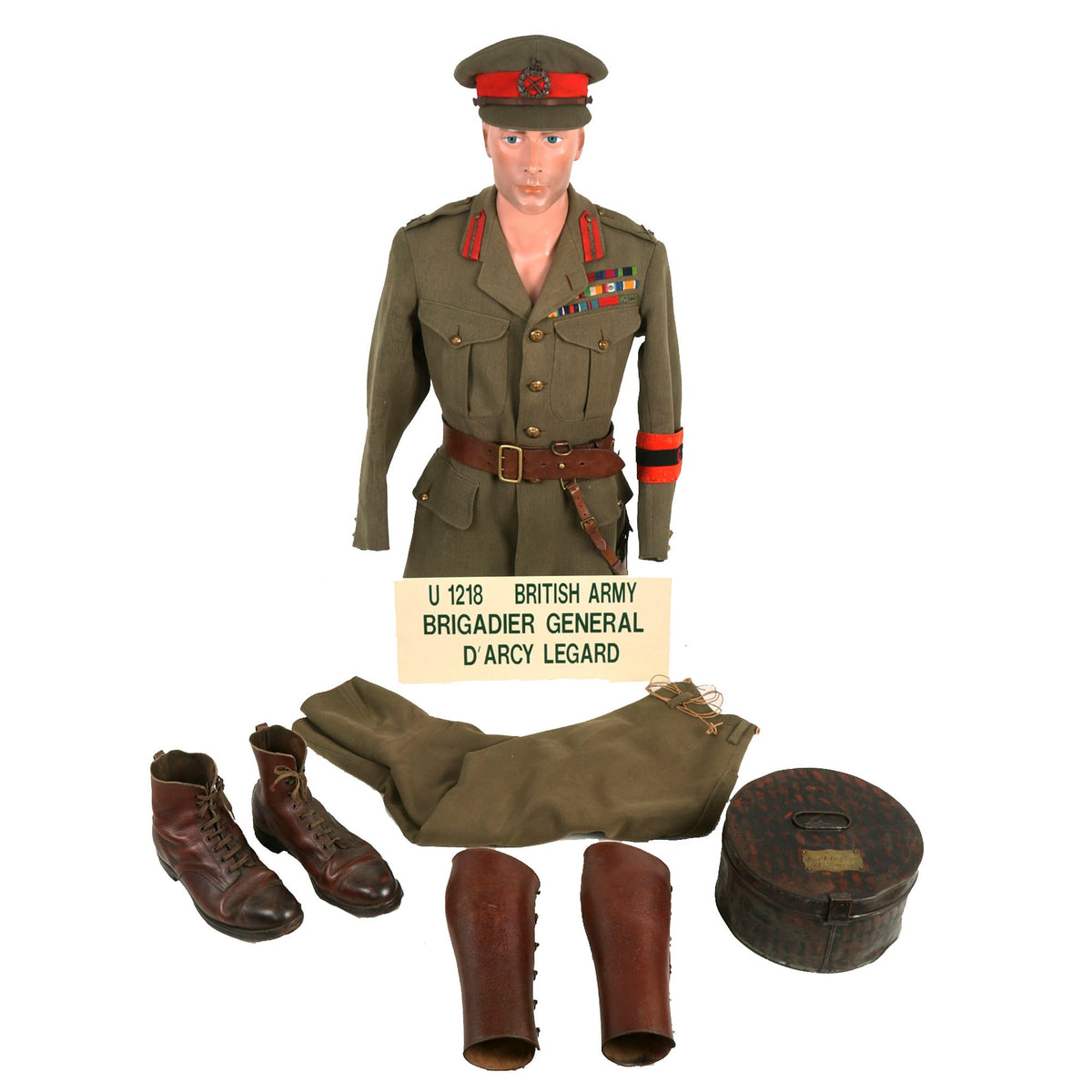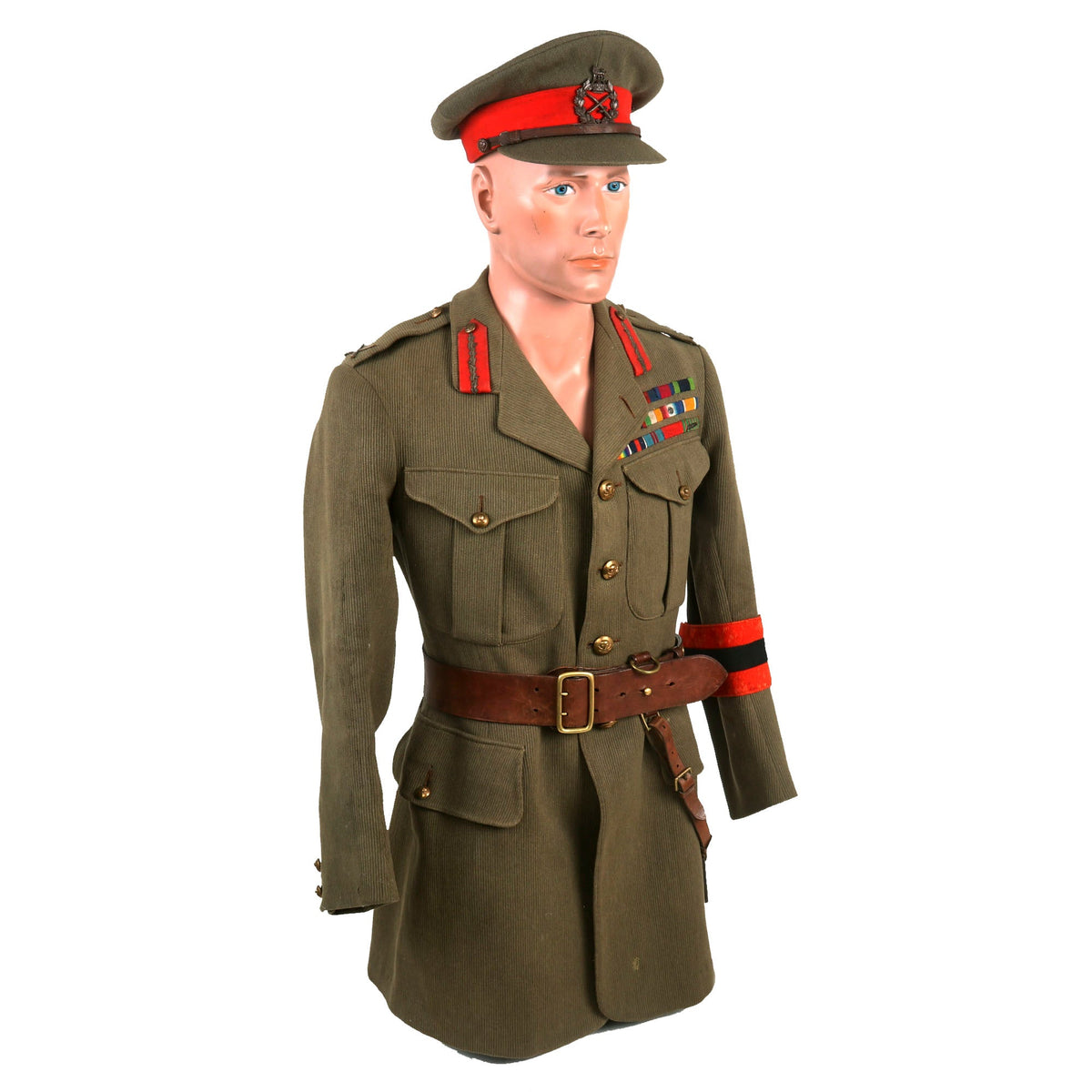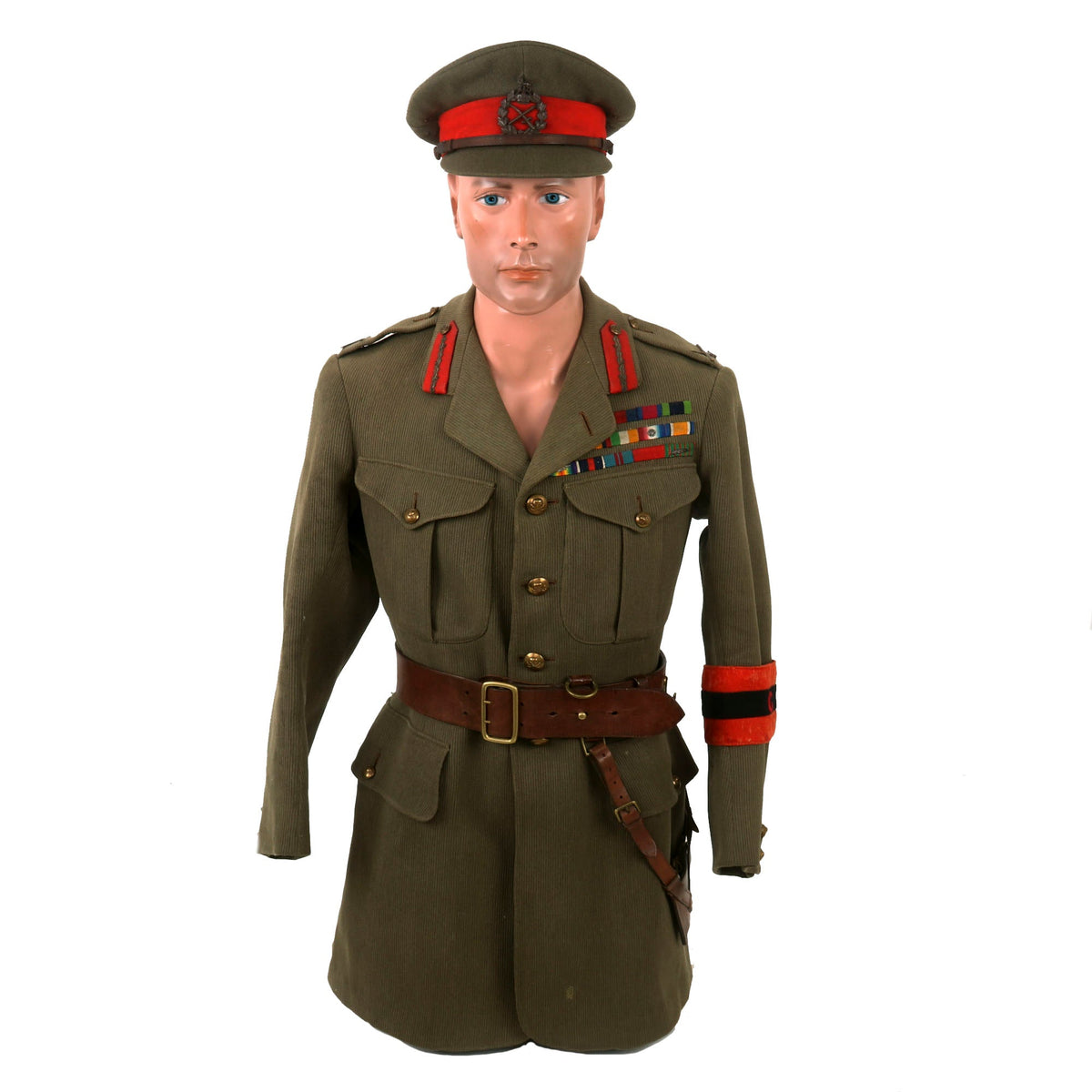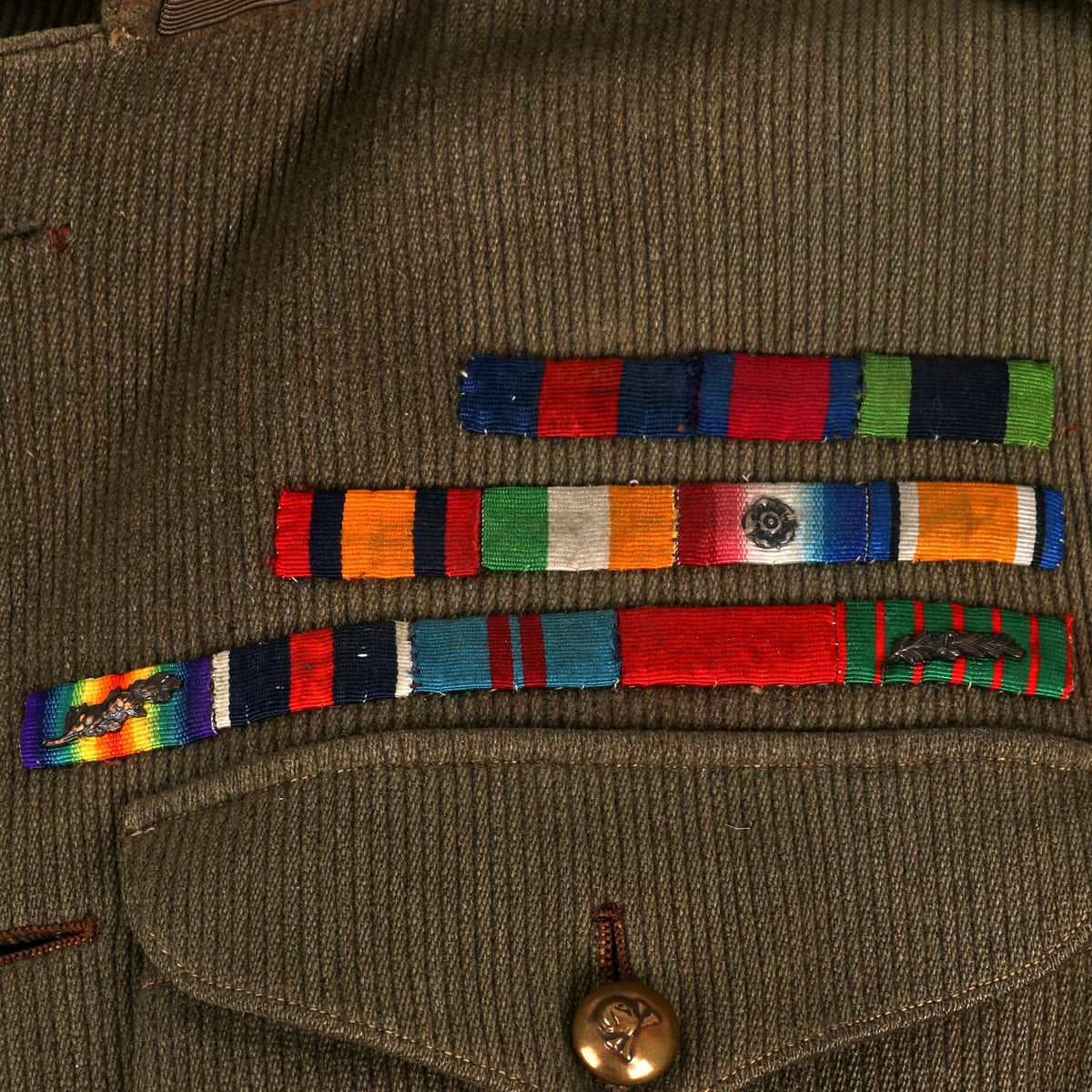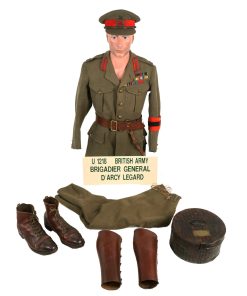Original British WWI 17th Hussars Brigadier General D’Arcy Legand Bedford Cord Uniform – Formerly Part of the A.A.F. Tank Museum Original Items
$ 1.995,00 $ 498,75
Original Items: Only One Set Available. This is an extraordinary British Army Bedford Cord uniform set from the World War I era that belonged to a Cavalry Brigadier General named “D’Arcy Legard”. He joined the 17th Lancers Cavalry Regiment in 1896 and served as a Signal Officer between 1900 and 1901. During this time, he was severely wounded, yet he continued to serve in operations in the Orange Free State in 1900, including actions at Vet River and Sand River. He also served in further operations in the Transvaal, Johannesburg, Pretoria, Elands River, Orange River Colony, Bethlehem Witt Bergen Clocolan (Basuto border), and Diamond Hill, earning a mention in dispatches.
Legard became a General Staff Officer 3 War Office as Brigade Major, 2nd Cavalry Brigade 1907. He returned to his old regiment in 1911 and became General Staff Officer 1 for the Indian Cavalry Corps from 1914 to 1915. He commanded the 17th Lancers from 1915 to 1916, and then from 1916 to 1919, he commanded the Hussar (i.e., “Light Cavalry”) Brigade. Later, he became Colonel, and then a temporary Brigadier Major General in 1919. He was also an Army interpreter. Legard commanded the 6th (“Midland”) Cavalry Brigade from 1920 to 1924, after which he retired.
The uniform set includes a pair of correct-style trousers, but they are not Legard’s. However, the original uniform items that belonged to Legard in this grouping are a peaked service cap (approx size 56cm), a metal hat tin named after him, a pair of leather low-quarter boots, a pair of leather leggings, and a leather waist Sam Browne belt with a sword hanger. British Army General’s uniforms are rare, but a Cavalry General’s uniform is exceptionally so. The fact that Lancer Cavalry Regimental uniforms are also some of the rarest of all, makes this named and identified Cavalry General’s uniform truly spectacular. Legard was awarded many medals and awards, including the Queen’s South Africa Medal with 4 Clasps, the King’s South Africa Medal with 2 Clasps, the Chevalier Legion of Honor, the WWI Victory Medal with Palm, and the French Croix de Guerre with Palm.
This came to us from the American Armoured Foundation, Inc. Tank and Ordnance Memorial Museum. The AAF Tank Museum was a living memorial dedicated to the Tank and Cavalry soldiers of the world. Before 1981 some of the artifacts that make up the AAF Tank Museum was a private collection belonging to Mr. William Gasser. Mr. Gasser felt that his collection would be beneficial in educating present and future generations to the sacrifices made and the technologies gained during war. Therefore, in 1981 the AAF Tank Museum was established as a non-profit charitable organization, and Mr. Gasser donated his private collection to the Tank Museum. Mr. Gasser is still active as Volunteer Director and Curator of the Tank Museum and his knowledge of military history has been a great asset to the museum. Unfortunately after 20 years of operation it had to close its doors, which is when this was acquired.
Despite being worn, all the items have been well-maintained and are in great condition. The cap has been particularly well-preserved as it was stored in the tin storage case, and there are no signs of wear and tear. The boots and leather leg gaiters are also in solid condition with no significant damage or visible wear and tear on the outside. The uniform top does have some areas of mothing on the backside left. Overall, the items have been well-looked-after and are in excellent display condition.
Comes more than ready for further research and display.
Approximate Measurements:
Collar to shoulder: 10″
Shoulder to sleeve: 24”
Shoulder to shoulder: 15.5”
Chest width: 18″
Waist width: 17″
Hip width: 23″
Front length: 33″
Pants:
Waist: 16.5″
Inseam: 24″
The 17th Lancers (Duke of Cambridge’s Own) was a cavalry regiment of the British Army that was founded in 1759. It is well-known for its participation in the Charge of the Light Brigade during the Crimean War. In 1922, the regiment was merged with the 21st Lancers to create the 17th/21st Lancers.
At the beginning of the First World War, the 17th Lancers was stationed in Sialkot, India. The regiment landed in France in November 1914 as part of the 2nd (Sialkot) Cavalry Brigade in the 1st Indian Cavalry Division. They were sent to the Western Front to fight in their traditional cavalry role. The regiment fought in the Battle of Cambrai in November 1917. In February 1918, the regiment was transferred to the 7th Cavalry Brigade, which was part of the 3rd Cavalry Division. The regiment was used as mobile infantry, plugging gaps whenever the need arose. They served both as cavalry and infantry during the last-gasp German spring offensive.
After the Armistice was signed on 11 November 1918, the regiment remained in continental Europe and joined the British Army of the Rhine in Cologne, Germany. The 17th Lancers were then deployed to County Cork, Ireland, where they fought against the Irish Republican Army during the War of Independence. On 28 September 1920, IRA Volunteers led by Liam Lynch and Ernie O’Malley, raided the British Army barracks in Mallow, County Cork. They seized weaponry, freed prisoners and killed British sergeant W.G. Gibbs of the 17th Lancers. This was the only British Army barracks that was captured during the war. In 1921, the title of the regiment was changed to the 17th Lancers (Duke of Cambridge’s Own).
Fast Shipping with Professional Packaging
Thanks to our longstanding association with UPS FedEx DHL, and other major international carriers, we are able to provide a range of shipping options. Our warehouse staff is expertly trained and will wrap your products according to our exact and precise specifications. Prior to shipping, your goods will be thoroughly examined and securely secured. We ship to thousands clients each day across multiple countries. This shows how we're dedicated to be the largest retailer on the internet. Warehouses and distribution centres can be located throughout Europe as well as the USA.
Note: Orders with more than one item will be assigned a processing date depending on the item.
Before shipping before shipping, we'll conduct a thorough inspection of the items you have ordered. Today, the majority of orders will be delivered within 48 hours. The delivery time will be between 3-7 days.
Returns
The stock is dynamic and we cannot completely manage it because multiple stakeholders are involved, including our factory and warehouse. So the actual stock may alter at any time. It's possible that you may not receive your order once the order has been made.
Our policy is valid for a period of 30 days. If you don't receive the product within 30 days, we are not able to issue a refund or an exchange.
You can only return an item if it is unused and in the same state as the day you received it. You must have the item in its original packaging.
Related products
Uncategorized
Uncategorized
Uncategorized
Uncategorized
Uncategorized
Uncategorized
Band of Brothers ORIGINAL GERMAN WWII Le. F.H. 18 10.5cm ARTILLERY PIECE Original Items
Uncategorized
Angolan Rebel 1970s era 60mm Inert Display Mortar from Angolan Civil War Original Items
Uncategorized
Uncategorized
Uncategorized
Uncategorized
Uncategorized
Uncategorized
Uncategorized
Uncategorized
Uncategorized
Uncategorized
Uncategorized
Uncategorized
Uncategorized
Armored Burgonet Helmet & Polearm from Scottish Castle Leith Hall Circa 1700 Original Items
